What is a Composting Toilet System?

A composting toilet system typically comprises more than just a toilet and incorporates additional components to treat the toilet materials so they are safe to both people and the environment. The most common elements of a composting toilet system are the toilet to collect the material, a composting system to treat the material and a conveyance system from the toilet to the composting system.
While most people only consider the composting toilet itself, it is the composting toilet system that forms complete sanitation. This typically requires several stages such as capture, containment, conveyance, treatment and re-use.
While this may sound daunting, the individual components of a composting toilet system are simple and can be self made anywhere on the planet using locally sourced materials. Its part of the reason why we love composting toilets so much
This article is arranged into different sections outlined below for easy navigation and reference:
- How a composting toilet system works
- The Different Types of Composting Toilet System
- Commode Batch System
- Chamber /Mouldering Toilets
- Self Contained Toilet
- Continuous Systems
- Important Design Considerations that are often overlooked
- Liquids Management
- Conveyance Methods for Centralised Systems
- Sizing your Composting Toilet System
- Whole House Composting Toilet System
- Off Grid Composting Toilet System
- Composting Toilet System Cost
How a composting toilet system works
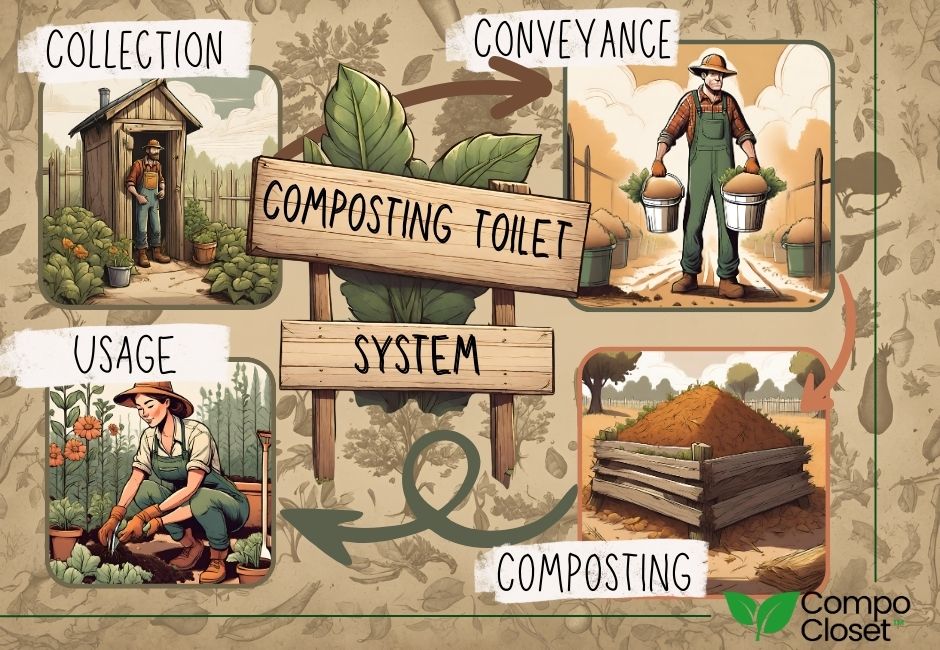
A composting toilet system is a complete solution for human bodily waste management that safely turns human "waste" into a nutrient rich resource. We're not fans of the term human waste management as it's only waste if you waste it! Instead, we prefer the terms toilet resources or toilet materials. Nevertheless, we may use human waste in this article for ease (and SEO until search engines catch up).
As the name suggests, a composting toilet system involves the process of composting which is defined as a controlled, aerobic (requiring oxygen) process that converts organic materials into a nutrient-rich, stable soil amendment or mulch through natural decomposition process by microorganisms and aerobic bacteria.
Simply, a compost toilet system has 4 stages:
-
Collecting and containing the excrement - both solid and liquid waste.
-
Conveyance to a composting chamber (optional)
-
Composting
-
Use or disposal of the end product
And that really is it.
The first 3 of these may occur within the toilet itself (a self-contained composting toilet) or may involve a separate compost pile or composting chamber. When the composting is separate from the toilet, a means of transport or conveyance is required. This can mean a conventional flush (really!), vacuum flush, gravity (thanks Isaac) or simply carrying your poop to your compost pile. We'll be covering the pros, cons, tips and resources to learn more about each type.
Once the Composting process is completed, you have a safe, mature nutrient rich soil amendment that bears no resemblance to the original matter that came out of you.
Types of Composting Toilet Systems
There are Three main types of Composting toilet systems. From simplest to most complex, these are:
-
Commode batch composting toilet system
-
Chamber/Mouldering Toilet system
-
Continuous Composting Toilet system
For chamber and continuous systems, these can be further segregated into two further systems:
-
self-contained
-
centralised (for a household or office/apartment building).
In this article we'll be covering all the pros and cons of all these systems with reference to resources for further information.
And a fourth type of composing toilet system (distributed)?
Commode Batch Composting Toilet
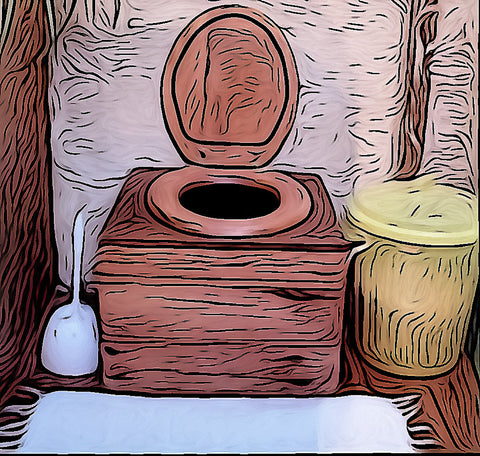
A commode batch composting toilet is often what most people think of when they think of a composting toilet. The Batch Commode is used from my home in London to Lima!
Batch composting toilets can be built anywhere on the planet with locally sourced materials for relatively little cost, yet can safely and independently scale manage the treatment of a household if managed correctly.
The popularity and acceptance of this type of system in the off grid scene owes in no small part to Joseph Jenkins who wrote The Humanure Handbook (Also available at your jungle-themed online retailer but support the guy!) A visionary for sustainable living, Jenkins outlines the science and practicalities of operating a composting toilet system. If you're considering this type of system, I can personally recommend reading the book.
Despite the simplicity of the batch commode, it needs to be supplemented by a managed compost pile (or a lot of buckets and a lot of time) to complete the composting process and be considered a composting toilet system.
Pros of the Commode Batch System
Simplicity
This type of system does not need urine diversion (see here) to function and be an odourless household solution.
Resilience and Self-Reliance
With simplicity, often comes reliability and this is especially the case with batch composting toilet systems! They typically have no moving parts and those that are used are easily available for replacement if they wear out.
Cost
This is the simplest and cheapest option for a composting toilet system. It can be constructed of locally available and often reclaimed resources anywhere on the planet.
Cons of the Commode Batch System
Time
I'm 100% sure Joseph will argue this is not a problem (Sorry). But for those accustomed to flush and forget, the Batch commode needs to be manually managed. Time can be reduced drastically by having the ability to store multiple buckets so that they can be emptied at the same time.
Chamber/Mouldering Toilet
A chamber or mouldering toilet can be thought of as a scaled up commode batch toilet. Typically, this type of toilet features a large chamber below the floor on which the toilet is located. The larger chamber means less frequent maintenance than the batch commode. Due to the larger chamber however, they typically requires a little more planning for access to the chamber.
Removable Bin
The first option for a chamber or mouldering toilet is a removeable bin. When the bin is nearly full it is removed and replaced with an empty one while the first is left to mature. Depending on usage, this system can scale by adding additional chambers so that a chamber is emptied when the contents are safe (after 12 months-2 years) and put back into use. Alternatively, the contents of the chamber can be transferred to a central compost pile and the chamber re-used immediately.
A plastic bin is commonly used for the chamber of this type of toilet as they are inexpensive and readily available. Wheelie bins are commonly used in toilets of this type as they are easier to move.
If multiple bins are going to be used and the contents left to mature within them, we recommend modifying the original bin with ventilation pipes (often described as bioreactors) to ensure sufficient oxygen throughout.
When transferring to a central pile, a raised platform with a lowered wall is advised to facilitate lifting and tipping the bin into the pile below.
Multiple Chamber or twin chamber composting toilets
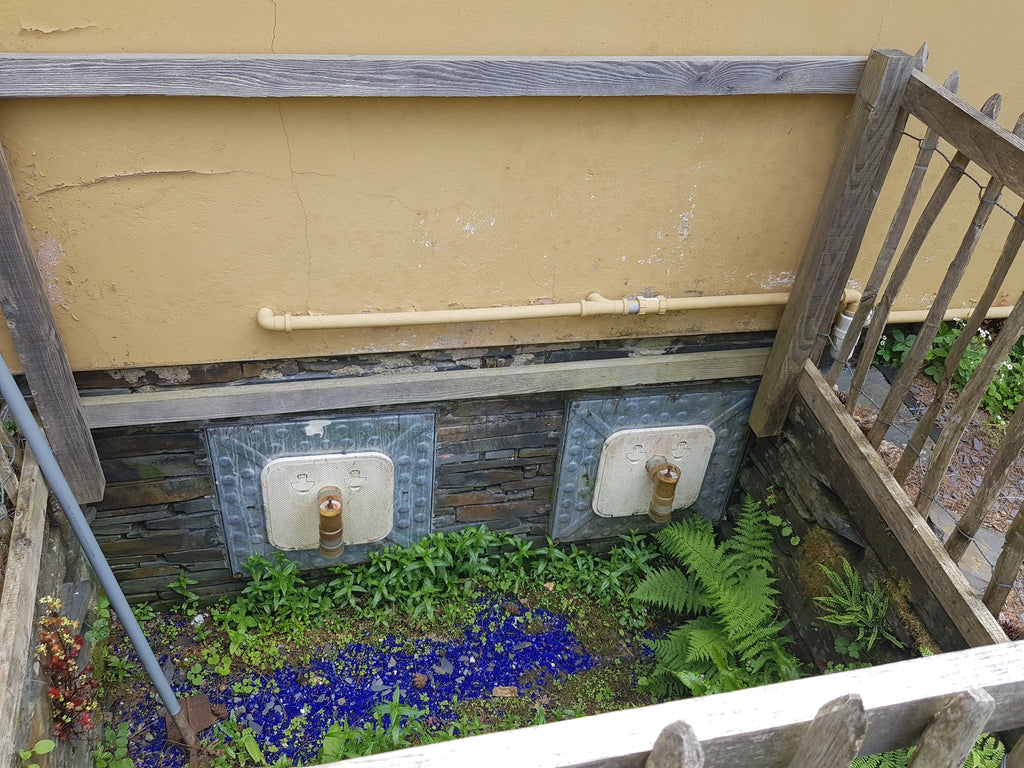
An alternative setup to the removable bin setup is to have a twin-chamber system. The first chamber is filled before it is closed off. The contents of the first chamber then mature while the second chamber is used and fills up.
It is important to size the chambers appropriately so that the first chamber has time to become sanitised while the second chamber fills. The appropriate sizing will depend on the number of users and frequency of use.
Once the second chamber is full, the contents of the first are removed and can be used as a soil amendment.
Pros and Cons
The largest benefit of this type of toilet vs the batch commode is the reduced maintenance due to having a larger chamber. The system is simple and relatively inexpensive, yet can scale to accommodate a large number of people if necessary.
A great advantage of the split system composting toilet is that the solid waste never needs to be handled until it is no longer solid waste at all! This makes them safer and maintenance far less objectionable.
While fluids management is relatively straightforward in all composting toilets, in these systems it is important due to the increased size of the chamber. Urine diversion greatly simplifies the liquid management and reduces the potential for problems with a clogged leachate drain.
Not all sites will have space for a redundant toilet and compost chamber in convenient proximity. The larger size of the chambers means that manually excavating the contents is a physical task. This may be beyond the capabilities of the elderly or less physically able people.
Self Contained Composting Toilet System
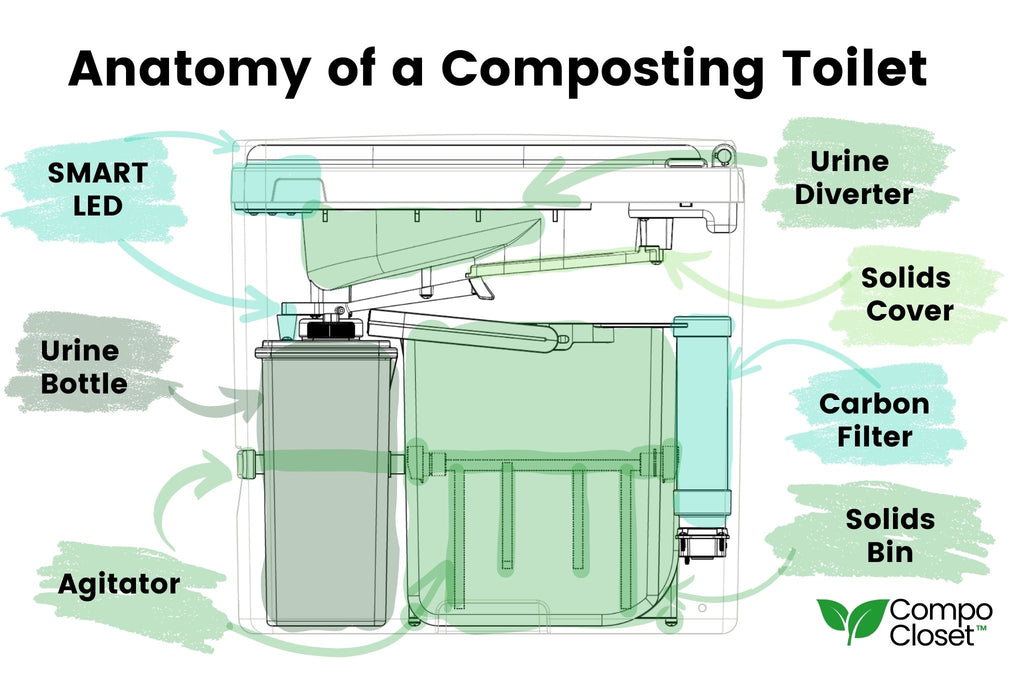
These are probably the most common type of composting toilet that people think of. The benefit of a self contained composting toilet is that all the hardware for ventilation and agitation is contained within the toilet. Most require power for fans and/or motors but they are otherwise self-sufficient.
Their self-contained and waterless nature makes them a good solution for retrofitting where there is no water supply or waste plumbing such as temporary guest accommodation. Because of their smaller size, they tend to be intended for seasonal and recreational use, or for a small number of users.
Continuous Composting Toilet systems
Continuous composting toilet systems, continuously treat new additions of solid waste without the need to stop using the toilet.
These are the largest and most complex of composting toilet systems and when installed and maintained can accommodate multiple people using them full time.
Because there is not a complete physical barrier between treated and un-treated materials, care must be taken to avoid contamination during any maintenance of the system or through the flow of liquids.
The most common type of continuous system is an inclined plane where materials compost above a grate angled between 20-30 degrees before falling down through the grate once composted. This system typically requires some infrequent emptying of the completed materials as well as intermittent breaking up or distribution of the recent deposits above the grate to prevent them clogging the grate. Typically, both these tasks are required every 2-3 months.
Pros/Cons
The main benefit of a continuous composting toilet system is infrequent emptying.
Probably the biggest downside of larger centralised systems is their cost and complexity. Because of their increased size, the difficult and unpleasant maintenance task when something goes wrong can be deterrent to installing one. .
Centralised Composting Systems
Both Chamber and continuous composting systems can be centralised with the addition of one or more appropriate conveyance mechanisms (more on that later) such as direct drop or vacuum, foam or low flush toilets. This may allow for a whole house composting toilet system to be implemented or even retrofitted.
Split system composting toilets
A split system composting toilet is one where the composting chamber is separate from the pedestal or toilet itself with a means of conveyance such as a chute as a means of conveyance. This is different to a self-contained system whereby composting happens within the toilet.
Important Considerations that are often overlooked
When considering the complete composting toilet system there are several practical factors that need to be considered but which are often overlooked. In this section we'll take a look at these in more detail.
Ease of emptying and access
Care should be given to the planning of routine maintenance when designing composting toilet systems. Even for self-contained toilets, be mindful of needing to remove and disassemble the entire toilet. These can be large and not designed for carrying. When designing Cuddy, one of the primary requirements was to be able to easily remove the solids bin (with agitator) to prevent disassembly of the entire toilet.
For larger systems, ensure sufficient space to access service hatches and manoeuvre larger, heavier bins. Accessing cramped crawl spaces will quickly become tiresome.
Getting to the compost pile
Proximity to the compost pile and sufficient space for accessing it is also important. Will you be rolling or carrying the chamber? if you are rolling, will you need a ramp? if you are carrying, will this be a one-handed task or will both your hand be free? Is there space and light to work safely?
Weight (Size) of solids bin
Don't under-estimate the weight of your toilet materials! While a larger bin means less emptying, it also means more weight. A 5-gallon, 20Litre container is a practical size without being a burden to carry.
Choice of material
Wooden compost toilets
Wood is commonly used for batch commode type toilets but can be susceptible to the humid environment inside if insufficient cover material is added. When making a wooden toilet, marine or treated material will be longer lasting and a ventilation fan to expel the excess moisture is advised.
Wooden composting pile structures
Wood is a suitable material for your compost pile due to its abundance and cost. Like all outdoor wooden structures, care must be taken to maintain it through the different seasons. It is common practice to separate the timber structure from the composting material with straw, hay or similar. This will keep the center of the compost pile insulated and warm, allow ventilation and protect the wood from the carbon-hungry bacteria in the compost.
Easy-Cleaning
Choosing a construction material for your compost toilet which is easy to wipe down will make cleaning easier. Plastic or ceramic are commonly used due to not easily absorbing odors or moisture. Fiberglass and wood can have a textured finish that makes removal of misplaced sawdust or worse difficult.
Concrete
Concrete is sometimes used for the floor of a leachate system or composting pile. Concrete can become pitted and corroded by the precipitation of urine deposits and humic acids in the compost, which can inhibit drainage. Consider sealing the compost with an acid-resistant sealer such the as silicone or epoxy based sealers sometimes used on roofs.
How the Composting Bit Works

In 2018, the US Composting Council defined compost as "the product manufactured through the controlled aerobic, biological decomposition of biodegradable materials. The product has undergone mesophilic and thermophilic temperatures, which significantly reduces the viability of pathogens..." Composting can then be defined as the controlled process that produces compost.
During composting, microorganisms feed on the carbon and nitrogen in organic materials to grow and reproduce. These microorganisms require oxygen to break down the organic materials into carbon dioxide, water vapor and a dark brown nutrient rich soil amendment we call compost.
While composting uses natural microorganisms, it is a controlled processes and requires specific conditions to be effective. The four conditions that need to be managed are:
-
Moisture
-
Carbon Nitrogen Balance
-
Oxygen
-
Temperature
Moisture Management and Separation of Liquids
Ensuring the correct moisture levels in the composting process prevents the pile becoming water logged and anaerobic. Anaerobic conditions often arise from too much moisture and lead to the creation of methane and other smelly gases.
A large active compost pile will generate heat to evaporate some liquids and can absorb some rain water. Evaporated liquid is why compost piles shrink so much (poo is 85% water!). Covering the pile with a tarp during heavy rain will help to keep water out and prevent the compost pile becoming saturated. Additional liquid that drains out of a compost pile is called leachate.
Leachate
Leachate is the liquid that may drain from a composting toilet system if liquids are not evaporated. Liquids that have drained down through the compost pile can be considered similar to black water due to the contamination with the faeces. Unlike source-separated urine, liquids that filter through the compost should be treated as black water.
Urine diversion
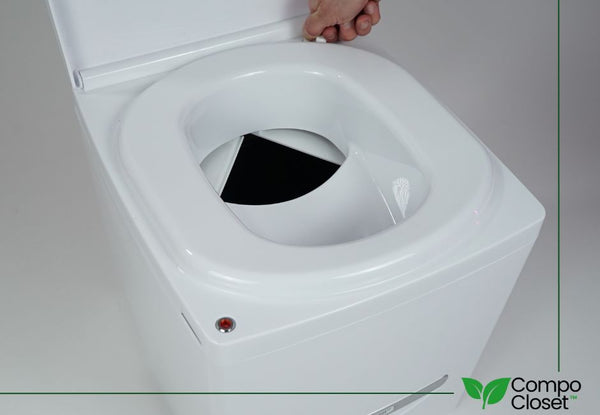
Urine Diversion is a common liquid management technique for waterless toilets. Urine diversion works by separating the liquid and solid wastes. Urine diverting toilets differ from traditional toilets by separating liquid waste at source through a specially designed bowl.
There are 4 key reasons to use urine diverting toilets in your compost toilet system:
-
To reduce odor - particularly in systems that employ large collection chambers.
-
To reduce liquid waste loading that leads to anaerobic conditions
-
To reduce the addition of cover material (and hence fill the toilet more slowly)
-
To use as Fertilizer
In smaller toilets, divertied urine is typically collected in a urine container located under the toilet seat. For toilets that are used more frequently, the urine can be plumbed away or stored in a larger separate container for later use as fertiliser.
Addition of carbon-rich materials
For waterless toilets to be composting toilets a carbon rich material needs to be added to balance out the nitrogen in the faeces. The ratio of carbon to nitrogen should be 30:1. The microorganisms that do the work of the composting process feed on the carbon in the solid waste to produce largely carbon dioxide and water.
The choice of carbon-rich cover material also helps ensure there is oxygen for the microbes. Woody materials are harder to break down because of lignin and this can help trap oxygen within the small pores between particles. Check out this article on the choice of cover material for your compost toilet for more detail. The time to break down wood is part of the reason toilet paper is visible within the compost for some time.
The cover material also helps reduce odour as a physical barrier during the composting process.
Maintaining aerobic conditions
Composting is an aerobic process and it is important to ensure the microbes have access to oxygen throughout the compost. This is facilitated by the right choice of carbon materials to trap oxygen within the pile.
The design of the composting chamber or pile is also important to ensure sufficient ventilation and airflow. For some designs, ventilation is achieved with a small electric fan. For external piles, there are many designs for compost piles that can be built from wooden pallets, or wire fencing that provide excellent conditions for aerobic composting. In these, the structure is often lined with straw or hay to contain the contents, while allowing air to pass through to the compost.
Temperature
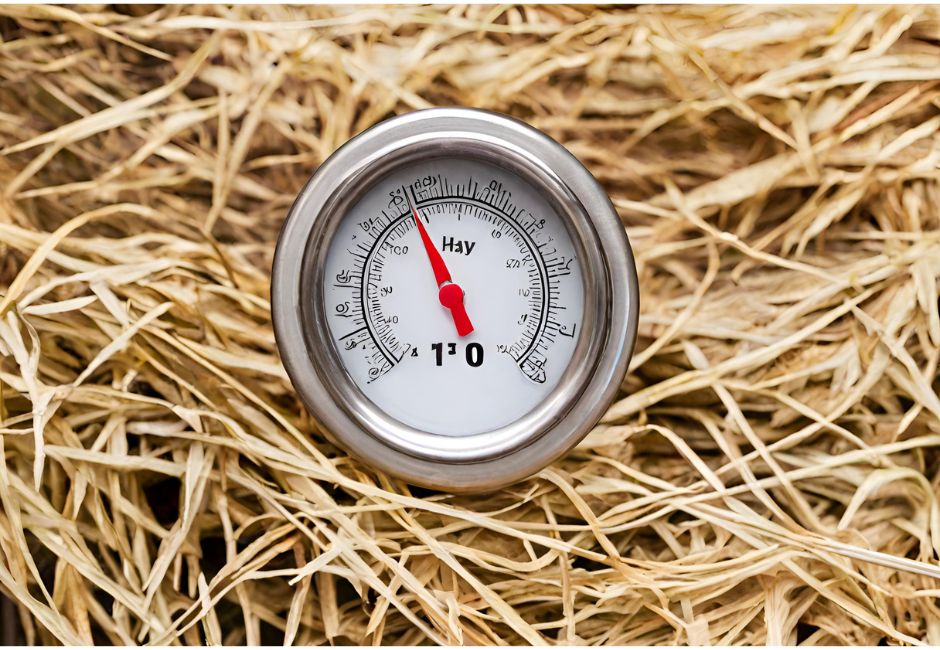
Temperature is another important factor for safe composting. If the composting process achieves sufficiently high thermophilic temperatures for a period of time this will ensure pathogens in the compost are deactivated and the compost is safe. The World Health Organisation recommends a composting at 131°F – 140°F (55°C – 60°C ) for one month with a further maturation period of 2 – 4 months in order to ensure pathogen reduction.
If thermophilic temperatures are not achieved, but only mesophilic temperatures (68 - 113°F or 20-45 °C), then the contents should be left for 12-24 months to mature before use.
Conveyance Methods for Centralised or Split Systems
Straight Drop
The simplest of all conveyance methods is gravity. This is for when the composting chamber is directly below the pedestal. A large diameter pipe (12" minimum) is required to reduce contact with falling faeces, however some contact will be inevitable and cleaning will be required. The problem is minimised for shorter drops.
It is the water seal in conventional toilets that prevents sewer smells coming back out of the toilet.
Micro flush and foam flush
A micro flush or foam flush toilet helps reduce the liquid in your composting chamber. This can then be dealt with as black water leachate. These toilets have the benefit of sealing odours from the chute.
This type of conveyance pipe often needs to be at a steeper gradient than a regular soil pipe. This may make retrofitting more of a challenge.
Aquatron - retrofitting a regular toilet
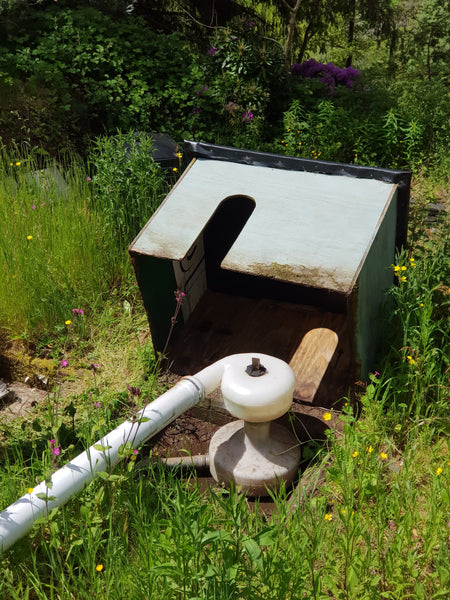
The Aquatron is possibly my favourite invention ever! This clever device separates flush water from the solids without any moving parts to reduce water in a composting chamber. This enables retrofitting of conventional pluming to a composting toilet system.
Composting Toilet System Size
Determining the appropriate size for a composting toilet system depends on several factors such as the number of people using it, the frequency of use, available space, and local regulations. Here's a general guide to help you decide:
-
Number of users: Estimate the maximum number of people who will be using the composting toilet regularly. This will give you an idea of the capacity needed to handle the waste produced.
-
Frequency of use: Consider how often the composting toilet will be used. If it's for occasional use, a smaller system may suffice. However, for regular or heavy use, you'll need a larger system with greater capacity.
-
Waste capacity: Look for composting toilets with specifications regarding waste capacity. This is usually measured in gallons or liters. Calculate the average amount of waste produced per person per day and multiply it by the number of users to estimate the required capacity.
Whole House Composting Toilet System
Whole house composting toilet systems are often used in off-grid or environmentally conscious homes where access to traditional sewage systems may be limited or impractical. They can help reduce water consumption, minimize pollution, and provide a sustainable alternative for managing human waste. However, it's important to research local regulations and ensure proper maintenance to ensure the safe and effective operation of the system.
Off Grid Composting Toilet System
An off grid composting toilet system, is completely possible. When off grid, eliminating the power and water requirements are the primary concerns, as well as ensuring a supply of carbon-rich cover materials. The simplest off grid system would be a batch commode system with sufficient cover material that a ventilation fan in the toilet is not required and several large compost piles that do not require any energy inputs. The little water for rinsing the solids buckets is often sourced from rainwater collection. If some ventilation is required in the home, this can be provided by a wind-powered cowling or solar-powered fan.
Composting Toilet System Cost
The cost of a composting toilet system can be very low for the batch and external compost pile type. Many industrious people have constructed systems largely from reclaimed materials.
For self contained units, the price can start at several hundred dollars for a Cuddy, or increase to over $2000 for models with heating.
Manufactured Central systems can cost upwards of $4000.
Composting Toilet and Greywater System
A composting toilet system can be used to handle solid waste, however a greywater system will be required to manage water for laundry, bathing and dish washing. A greywater system should not be used for handling leachate from the compost chamber as this should be considered black water due to contact with faeces.
What is a waterless Composting Toilet System?
A waterless composting toilet system is one where flush water is not used as a means of conveyance between the pedestal and the composting chamber. Instead, conveyance is either manual in the case of batch compost toilets or a gravity for split systems.
Is a Composting Toilet System Worth It?
A composting toilet system is a simple, reliable, safe and effective means of managing human waste. There is additional management vs a conventional septic system, however the upfront and ongoing costs of a composting system are much lower.
Distributed Off-Site Composting toilet systems
The popularity of composting toilets and both the simplicity and resilience of container based sanitation has seen composting toilets used in places such as Haiti and Madagascar where conventional sanitation methods are impractical. In these distributed systems, customers pay a small fee to have their toilet materials removed to a central location for composting and a fresh collection container provided.
Vermiculture Toilet Systems - Tiger Toilets

Some systems use vermiculture (worms) to help accelerate the breakdown of the solids and these are sometimes referred to as vermiculture, vermicomposting or tiger toilets (due to using tiger worms). We love these toilets, however, they are not strictly composting toilets as they don't satisfy the definition of composting. Instead, to avoid confusion, we prefer to call them vermiculture toilets - or tiger toilets because it sounds as awesome as these are!
How long do I have to Compost my Poo for?
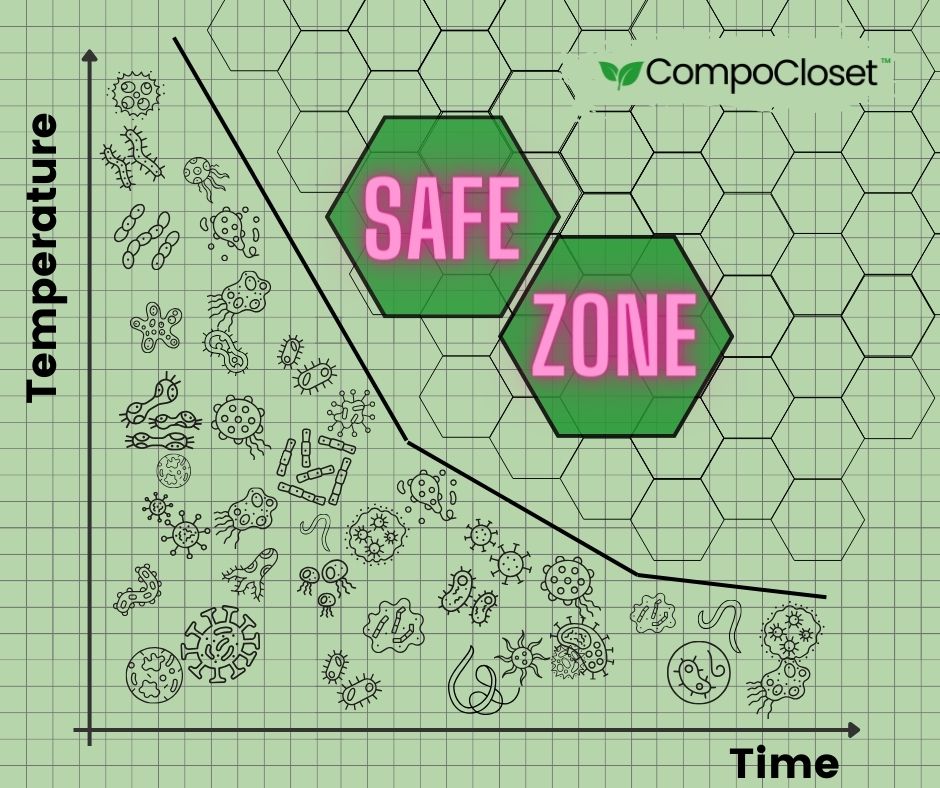
How long to compost solids will depend on the type of system and the temperatures achieved in the compost pile.
If Thermophilic conditions exist in the compost pile then the coolest area of the pile
-
1 hour at >70C at the coolest area of the pile.
-
3 days at >= 55C at the coolest area of the pile
If non-thermophillc conditions exist then
-
18 months >= 20C
-
24 months >=5C
How do I tell if my composted poo is safe to use?
Knowing the temperature of the compost pile over time is not always possible. If in doubt, additional time should be allowed to ensure pathogen attenuation.
Tomato seed hack
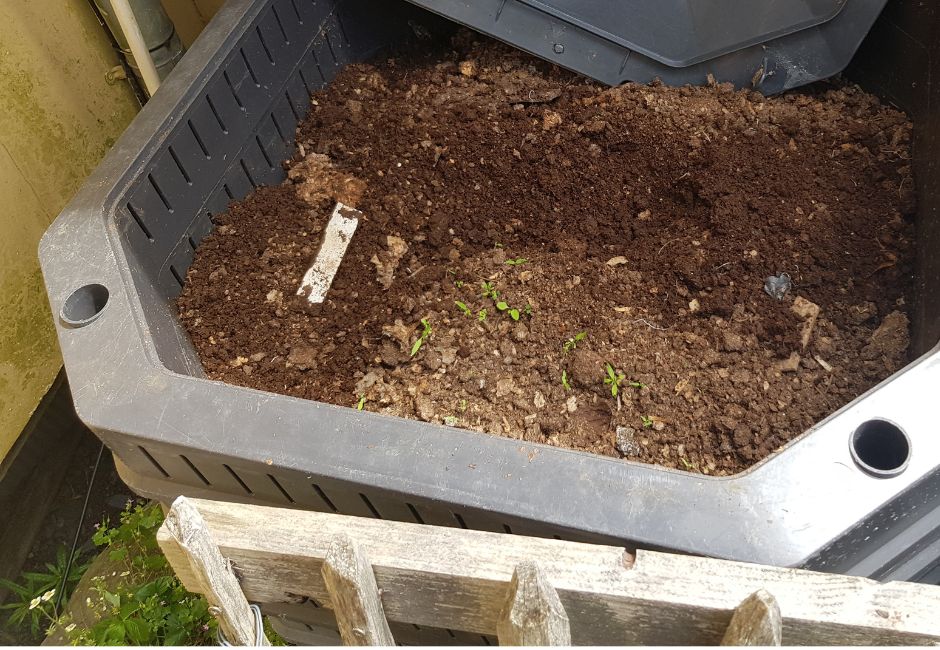
Research by Dr Jörn Germer et al, 2009 noted that hardy tomato seeds are very hardy and are deactivated by the same conditions as A. lumbrcoides parasitic worm eggs. Adding these tomato seeds to the compost at the same time as the faeces is an indicator of whether the conditions for pathogen attenuation have been achieved in the compost pile. When samples no longer contain germinating seeds you can be reasonably assured that the parasitic worm eggs are also destroyed.
If you have questions or comments to improve this article please contact the author!
0 comments


